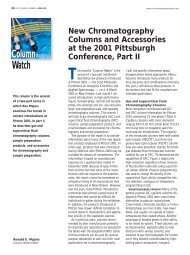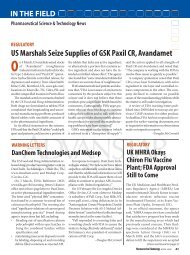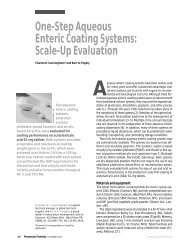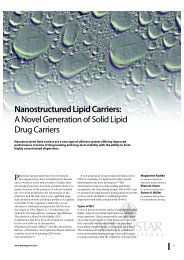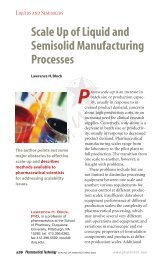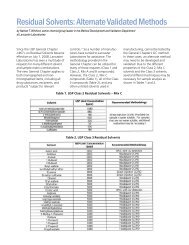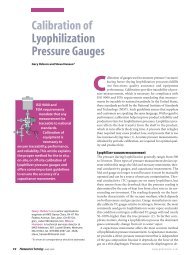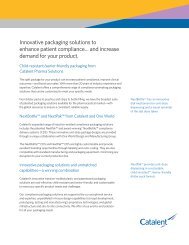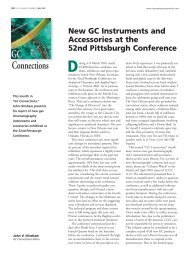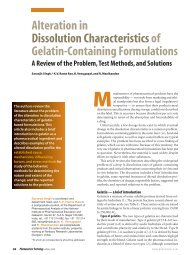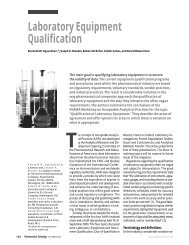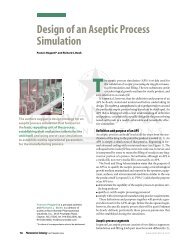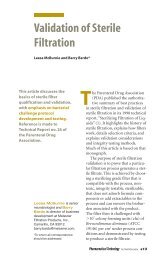The Role of the Column in Preparative HPLC - Chromatography ...
The Role of the Column in Preparative HPLC - Chromatography ...
The Role of the Column in Preparative HPLC - Chromatography ...
Create successful ePaper yourself
Turn your PDF publications into a flip-book with our unique Google optimized e-Paper software.
418 LCGC NORTH AMERICA VOLUME 22 NUMBER 5 MAY 2004 www.chromatographyonl<strong>in</strong>e.com<br />
Figure 1: Method development strategy for scale-up.<br />
columns conta<strong>in</strong><strong>in</strong>g <strong>the</strong> same column-pack<strong>in</strong>g<br />
material, ei<strong>the</strong>r <strong>in</strong> prepacked columns<br />
or <strong>in</strong> bulk media that users can pack. <strong>The</strong>n,<br />
us<strong>in</strong>g <strong>the</strong> equations shown <strong>in</strong> Figure 2, <strong>the</strong><br />
scale-up should be l<strong>in</strong>ear with perhaps only<br />
m<strong>in</strong>or adjustments required to f<strong>in</strong>alize <strong>the</strong><br />
preparative method. It is highly recommended<br />
that one ensures that both analytical<br />
and preparative columns from <strong>the</strong> same<br />
l<strong>in</strong>e <strong>of</strong> pack<strong>in</strong>g material be readily available<br />
before beg<strong>in</strong>n<strong>in</strong>g <strong>the</strong> preparative method<br />
development and optimization process.<br />
Table I Guidel<strong>in</strong>e for capacity <strong>of</strong><br />
preparative LC columns<br />
<strong>Column</strong> i.d. a, 1.2 a. 1.5<br />
4.6-mm 2–3 mg 20–30 mg<br />
9.4 10–20 100–200<br />
21.2 50–200 500–2000<br />
raphy (IEC) sometimes are used for preparative<br />
scale-up and purification. A typical<br />
preparative use for SEC might be for <strong>the</strong><br />
elim<strong>in</strong>ation <strong>of</strong> high molecular weight compounds<br />
or for prote<strong>in</strong> purifications. <strong>The</strong><br />
IEC technique is used for <strong>the</strong> preparation<br />
<strong>of</strong> <strong>in</strong>organic or organic ionic compounds<br />
such as prote<strong>in</strong>s. Both techniques are used<br />
sometimes <strong>in</strong> conjunction with o<strong>the</strong>r<br />
preparative modes. Of course, chiral<br />
preparative separations can be achieved on<br />
preparative versions and such columns can<br />
be purchased, but <strong>the</strong> cost <strong>of</strong> such columns<br />
relegates <strong>the</strong>m to <strong>the</strong> specialty column category.<br />
Supercritical fluid chromatography<br />
has found use <strong>in</strong> large-scale purification <strong>of</strong><br />
enantiomeric materials.<br />
For decades, adsorption chromatography<br />
on silica gel or o<strong>the</strong>r liquid–solid media<br />
(such as alum<strong>in</strong>a and kieselguhr) was <strong>the</strong><br />
ma<strong>in</strong> technique for purification <strong>of</strong> a variety<br />
<strong>of</strong> syn<strong>the</strong>tic organic mixtures as well as<br />
o<strong>the</strong>r sample types. However, <strong>the</strong> overwhelm<strong>in</strong>g<br />
popularity <strong>of</strong> reversed-phase<br />
chromatography <strong>in</strong> <strong>the</strong> analytical world has<br />
shifted <strong>the</strong> emphasis to this mode <strong>of</strong> operation<br />
for preparative LC. Also, many analytical<br />
<strong>HPLC</strong> users are not familiar with <strong>the</strong><br />
pr<strong>in</strong>ciples <strong>of</strong> adsorption chromatography;<br />
<strong>the</strong>y are more comfortable with reversedphase<br />
chromatography and for this reason,<br />
tend to gravitate to it when fac<strong>in</strong>g a<br />
preparative need.<br />
Liquid–solid (and normal phase) <strong>HPLC</strong><br />
uses organic solvents that are more volatile<br />
compared with <strong>the</strong> aqueous-based solvent<br />
systems used <strong>in</strong> reversed-phase chromatography.<br />
In addition, normal-phase solvents<br />
Choos<strong>in</strong>g <strong>the</strong> Appropriate Mode<br />
and Stationary Phase <strong>in</strong><br />
<strong>Preparative</strong> <strong>Chromatography</strong><br />
In preparative scale-up, <strong>the</strong> same separation<br />
modes that were used <strong>in</strong> analytical-scale<br />
chromatography can be employed. However,<br />
due to cost and availability <strong>of</strong> high<br />
performance preparative pack<strong>in</strong>g materials,<br />
<strong>the</strong> cost <strong>of</strong> mobile phase and mobile-phase<br />
additives, <strong>the</strong> high throughput requirements,<br />
and <strong>the</strong> need to recover isolated<br />
fractions <strong>in</strong> a high purity state, users <strong>of</strong>ten<br />
limit <strong>the</strong>mselves to <strong>the</strong> more popular<br />
modes <strong>of</strong> adsorption and reversed-phase<br />
chromatography. Size-exclusion chromatography<br />
(SEC) and ion-exchange chromatoghave<br />
a higher solubility for many compounds,<br />
and reversed-phase chromatography<br />
<strong>of</strong>ten displays a lower sample capacity<br />
for compounds due to lower solubility. For<br />
compound recovery, <strong>the</strong> isolated fractions<br />
from a normal-phase separation can be<br />
recovered quickly by evaporation <strong>of</strong> <strong>the</strong><br />
volatile organic solvent. On <strong>the</strong> o<strong>the</strong>r hand,<br />
at <strong>the</strong> conclusion <strong>of</strong> reversed-phase chromatography<br />
purification, <strong>the</strong> collected<br />
solutes are <strong>in</strong> a predom<strong>in</strong>antly aqueous<br />
medium. <strong>The</strong> removal <strong>of</strong> <strong>the</strong> water to concentrate<br />
and recover <strong>the</strong> purified fraction<br />
might take much longer or necessitate additional<br />
isolation steps such as desalt<strong>in</strong>g or<br />
solid-phase extraction. <strong>The</strong> use <strong>of</strong> higher<br />
temperatures to evaporate aqueous media<br />
can stress <strong>the</strong> isolated drug or biomolecule<br />
or even destroy it dur<strong>in</strong>g <strong>the</strong> concentration<br />
process. Thus, it is important to test <strong>the</strong><br />
temperature stability dur<strong>in</strong>g <strong>the</strong> analyticalscale<br />
method development before scal<strong>in</strong>g<br />
up to preparative scale.<br />
One consideration <strong>in</strong> preparative chromatography<br />
that usually is <strong>of</strong> lower importance<br />
<strong>in</strong> analytical chromatography is <strong>the</strong><br />
sample capacity <strong>of</strong> <strong>the</strong> pack<strong>in</strong>g material.<br />
Because throughput is a primary criterion<br />
<strong>in</strong> preparative LC, columns with higher<br />
capacity can handle more material per<br />
<strong>in</strong>jection. For adsorption chromatography,<br />
<strong>the</strong> surface area <strong>of</strong> an adsorbent dictates <strong>the</strong><br />
capacity. A higher surface area sorbent will<br />
allow <strong>in</strong>jection <strong>of</strong> larger sample masses than<br />
a lower surface area sorbent. In reversedphase<br />
chromatography, <strong>in</strong> addition to solubility<br />
<strong>of</strong> <strong>the</strong> analyte, <strong>the</strong> bonded-phase coverage<br />
determ<strong>in</strong>es <strong>the</strong> sample capacity.<br />
Although one might th<strong>in</strong>k that <strong>the</strong> capacity<br />
<strong>of</strong> <strong>the</strong> reversed-phase chromatography<br />
media is dictated by <strong>the</strong> alkyl cha<strong>in</strong> length<br />
<strong>of</strong> <strong>the</strong> bonded phase (for example, C 18 versus<br />
C 4 ), it is more <strong>in</strong>fluenced by <strong>the</strong><br />
bonded-phase coverage.<br />
Surface coverage <strong>of</strong>ten is expressed as<br />
micromoles per meter squared. For a typical<br />
silica-gel pack<strong>in</strong>g, <strong>the</strong>re are roughly<br />
8 mmol/m 2 <strong>of</strong> surface silanols available for<br />
bond<strong>in</strong>g. Because <strong>in</strong> adsorption chromatography<br />
<strong>the</strong> silanol group is responsible for<br />
analyte retention, <strong>the</strong> larger <strong>the</strong> surface area<br />
is, <strong>the</strong> more silanols that are present and<br />
<strong>the</strong> greater <strong>the</strong> retention. In reversed-phase<br />
chromatography, <strong>the</strong> mechanism is<br />
hydrophobic <strong>in</strong>teraction between <strong>the</strong> alkyl<br />
and aryl groups on <strong>the</strong> analyte with <strong>the</strong><br />
bonded phase. For a typical monomeric<br />
C18 bonded phase, for steric reasons, <strong>the</strong><br />
bonded-phase coverage usually is <strong>in</strong> <strong>the</strong><br />
range <strong>of</strong> 2.5–3 mmol/m 2 . Due to its smaller<br />
footpr<strong>in</strong>t on <strong>the</strong> surface, a monomeric C8



